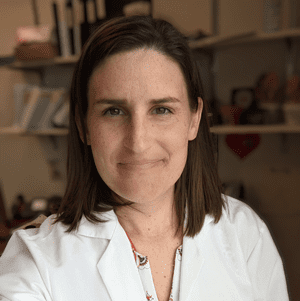Posted By: Kylee Spencer, PhD, Assistant Editor, AJHG
Each month, the editors of The American Journal of Human Genetics interview an author of a recently published paper. This month we check in with Melissa to discuss her recent paper “Functional characterization of 2,832 JAG1 variants supports reclassification for Alagille syndrome and improves guidance for clinical variant interpretation.”

KS: What motivated you to start working on this project?
MG: During the pandemic, I found myself at home with three kids under five and adjusting to a totally new type of “normal,” which drove me to reprioritize my research goals. Being physically away from the bench, I dug into the literature to identify scalable methods for a problem that had been nagging at me: the overwhelming burden of Variants of Uncertain Significance (VOUS) in the clinical lab. I had been studying Alagille syndrome for years, and although we had a good understanding of the disease genes and the pathomechanism (haploinsufficiency), we really didn’t know how to classify all the missense variants that were being identified, many of which are novel and not usually seen in a second individual, earning the designation of VOUS. We were frequently receiving emails from clinicians world-wide asking for help in interpreting missense VOUS from clinical genomic reports for their patients, who often had widely varying clinical phenotypes that complicated an Alagille syndrome diagnosis. In most of these cases, we were unable to provide much clarity beyond confirming the VOUS classification. Once I read about the pioneering studies establishing methodologies for Multiplexed Assays of Variant Effects (MAVEs), I knew it would be a great system to set up for Alagille syndrome.
KS: What about this paper/project most excites you?
MG: Although this particular project focuses on one gene, my excitement stems most from the widespread utility of these assays. For this project, we designed a high-throughput membrane expression assay to test the functional effects of variants in JAG1, a transmembrane protein. Roughly 20-30% of all proteins are transmembrane, and there have been other labs that have designed successful, high-throughput assays for membrane proteins. Extension of these types of assays to other disease genes is very exciting, and as more labs adopt high-throughput workflows and pipelines, the ability to comprehensively interrogate all genomic variants becomes possible.
On a personal level, I have been involved in Alagille syndrome research and the Alagille Syndrome Alliance, a family and patient advocacy organization, for nearly 10 years. Knowing that this work will have direct effects on improving diagnostics and increasing knowledge about the functional effects of thousands of variants, is very rewarding.
KS: Thinking about the bigger picture, what implications do you see from this work for the larger human genetics community?
MG: We are currently in an era of great advances in genome sequencing, which has introduced a massive bottleneck in our ability to understand DNA variation. Although we can identify variants at an unprecedented scale, we are lagging behind in our understanding of how variants affect protein function. Removing this bottleneck is a huge goal and functional resolution of protein effects at a scalable level really is the next stage of genomic diagnostics. I am very excited about incorporating these types of datasets into clinical workflows to help reduce the uncertainty burden.
KS: What advice do you have for trainees/young scientists?
MG: I have a few pieces of advice! First, don’t lose sight of your passions. Most of us go to grad school for a purpose and it is easy to lose sight of that purpose when you are in the thick of experiments that may not be working. Remind yourself as you near the end why you went and seek opportunities that align with what drives you. Second, attend conferences, meet people, introduce yourself, talk about your projects. Interacting with others in your field, and sometimes outside of it, increases your creativity, helps you to see and think outside of the box, and can push your work in new directions. In many cases, you may find new collaborators, develop friendships with others in your field, and meet established experts who often have invaluable advice to pass on.
KS: And for fun, tell us something about your life outside of the lab.
MG: As a mom of three, I am quite busy outside of lab, where I am thoroughly enjoying my sports-mom era! The origin of our family is fun, however, as it involved a twist of genetics. My younger two children are fraternal twins (a boy and a girl), and ironically…but more likely, genetically…I also have a fraternal twin brother. Although I was shocked at the time, I learned later that there is about a 1/60 chance of females who are fraternal twins having their own fraternal twins. If my daughter has children when she grows up, it will certainly be interesting to see if there is a third generation of “womb-mates!”
Melissa A. Gilbert, PhD is an Assistant Professor in the Department of Pathology and Laboratory Medicine in the Division of Genomic Diagnostics at the University of Pennsylvania and the Children’s Hospital of Philadelphia.
